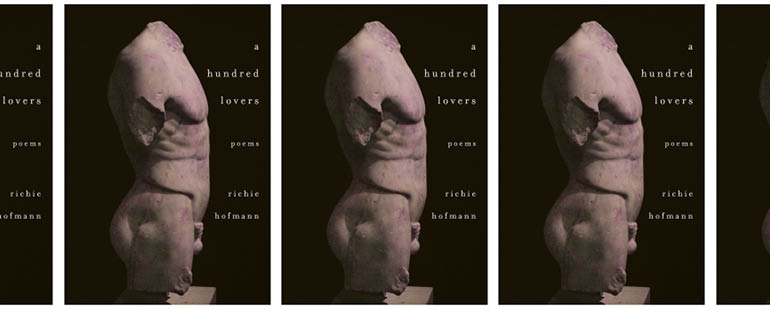Richie Hofmann’s Ekphrastic Poetry

There is a point in A Hundred Lovers, Richie Hofmann’s second collection of poems, at which the poet guides himself through a museum: “I’m by myself again, looking at bright green tapestries, / a painted box in which was kept / a human heart.” The poet is alone, coupled with the artifacts of a stranger’s life: a heart, the box that secured their heart, the painter who ornamented the box that secured a stranger’s heart. Here, in “Looking at Medieval Art,” the memory of violence conjured through medieval objects—“The medieval streets have been widened by / modern instruments of pain”—turns the poet’s attention to the present, or, rather, what the poem enacts in our present. Hofmann (who is a three-time contributor to Ploughshares), by way of making the poem, is together with this stranger’s heart; the poet experiences their loneliness only through the possibility of not being alone: “I look for a stranger with whom / to act out the gamut of jealousy, obsession, control— / until his body, like a soul, slips out from mine.”
The distinction of body from soul, the figurative relationship of body to soul, the heart and the ornamented box in which it’s been kept for hundreds of years: the eroticism of A Hundred Lovers, out last month, is energized, in part, by the transfusion of visual and musical works of art into poetry. Another poem, “Male Beauty,” reads: “In my favorite recordings, / you can hear the pianist breathing.” That a pianist, in the time it takes one to listen to their recordings, makes these sounds happen, that a poet arranges sentences in lines to inflect our experience of reading—sometimes we ourselves enunciating—these are the bodily markers that suggest a formal process of making. In the case of this pianist and the poet who listens, one cannot embellish their breath; the musician’s attention is given to the instrument, projected outwardly. Likewise, in the case of A Hundred Lovers and its movements between erotic experience and the erotic in art, one does not embellish what they have observed, what they remember: “When we were very young, your forgiveness / humiliated me” is articulated as plainly, as matter-of-fact as “It is night outside / and raining.”
Perhaps to ornament one’s notion of forgiveness and humiliation—the painted box that both protects and conceals a heart—is to obscure what, exactly, suggests the erotic. Elsewhere, in “City of Violent Wind,” one of two long poems in the collection, the poet remembers watching the pianist Louis Lortie perform in Chicago and reflects, “All technique, no passion, a critic said, but that was what I liked.” Can technique really manifest itself without passion, or does Hofmann’s imaginary critic wish their notion of passion was made palatable—ornamenting technique—to the imaginary audience? Syntax and lineation is technique; passion is not the statement of passion, but rather the ways in which syntax and lineation arrange an experience for Hofmann’s readers. This is why, in the second long poem of A Hundred Lovers, the poet identifies language as a vehicle for and a semantic reduction of desire: “We both distrust // abstraction. Later, when we’re tired of walking, let’s stop in front / of some beautiful place and tell each other what we want.” Only through abstraction can the poet and his lover talk about what they want: abstraction as desire, abstraction made tangible as an image in our minds. The poem ends (and so the book ends) after the couple asks for directions: “If we reach the tower, / the scrap of paper says, we’ve gone too far.” Because we’re never meant to reach the tower, because the tower is a mark of error within this context, the tower exists only at the end of our minds: there, you see it, we’ve travelled too far.
A hundred lovers, a hundred and five lovers, or five lovers: the distinction strikes one as necessary to name and arbitrary to count. They exist more immediately in our minds than the far-out tower. In “Pernod,” titled after the French liqueur, the poet remembers sleeping without a shirt, dreaming “light BDSM dreams,” counting and naming: “To give oneself to a hundred lovers: hard. / To give oneself to one: also hard.” The erotic is animated not through information—not through the number itself—but through the arrangement of first, then second, then third, and, in this arrangement, naming the first “first” and the second “second” and the third “third.” In sequence, in context, the individual numbers resist generalization: the idea that technique can be recognized without even the most subtle hint of passion. So one looks at art just as they observe everything around themselves in a particular place, in a particular time: “I watched an older man and a younger man tanning themselves / by the freezing pool.”
In the poem one page earlier, “French Novel,” naming the second lover as such, in the lineage of a hundred (not one hundred), cannot quite be approximated as “also hard.” The second is introduced: “You were my second lover. / You had dark eyes and hair, / like a painting of a man.” Immediately one recognizes it is not descriptive information that makes this person memorable (at least those of us with “dark eyes and hair” would agree), but rather the way the poem elides this subject through its figurative painting: lines arranged by clause. The representation of a man—the figurative representation of a painting of a man—inheres only in the context of the poem. Similarly, in the sequence of a hundred lovers, the second inheres only in context, or as the poem’s final sentences conclude:
The French language distinguishes
between the second
of two and the second
of many. Of course
we’d have other lovers. Snow fell in our hair.
You were my second lover.
Another way of saying this:
you were the other,
not another.
Any lover named-as-number here could never be understood as another, which suggests the lover as separate from this sequence—or, importantly, separate from the life of the poet who arranges the sequence in the first place.
“You were my second lover. / You had dark eyes and hair, / like a painting of a man.” In a short essay accompanied by a poem (“Jupiter”) penned for the Nicholas Hall Gallery, “My Ekphrasis,” Hofmann writes about his relationship to visual art and its manifestation in his poetry: “Works of art provide me with something to measure the self against.” Poetry is a visual medium by way of its conductive metaphors: What heart do you imagine in the painted box? Poetry itself is barely a visual medium, if not for the presence that arranges the poem and, in this case, looks at what’s around them. It is commonplace wisdom—what wisdom is not commonplace?—that our enduring ekphrastic poems do not merely transcribe or represent their source material. Like all poems, they enact an experience (in sentences, very often in lines) for their readers; it is not their ekphrasis which makes them endure. This particular experience, however, happens to be guided by one’s own transformation while encountering a visual work of art—or, as Hofmann concludes in his essay, “When I wrote the ekphrastic poem, my aim was not merely to describe the appearance of the painting or to retell its classical narrative, but to capture something of my experience of the work’s Baroque sensuality.” Of course this is true, otherwise the poetry would not be ekphrastic. Perhaps one finds it compelling, instead, to think about how this experience is physical, both the act of standing beside a painting and the act of writing a poem. Where is the museum’s restroom, and what does my voice sound like when I read these poems aloud? If you reach the tower, you’ve gone too far—but you see the tower right there, it’s in your mind. You’ve already reached it.



